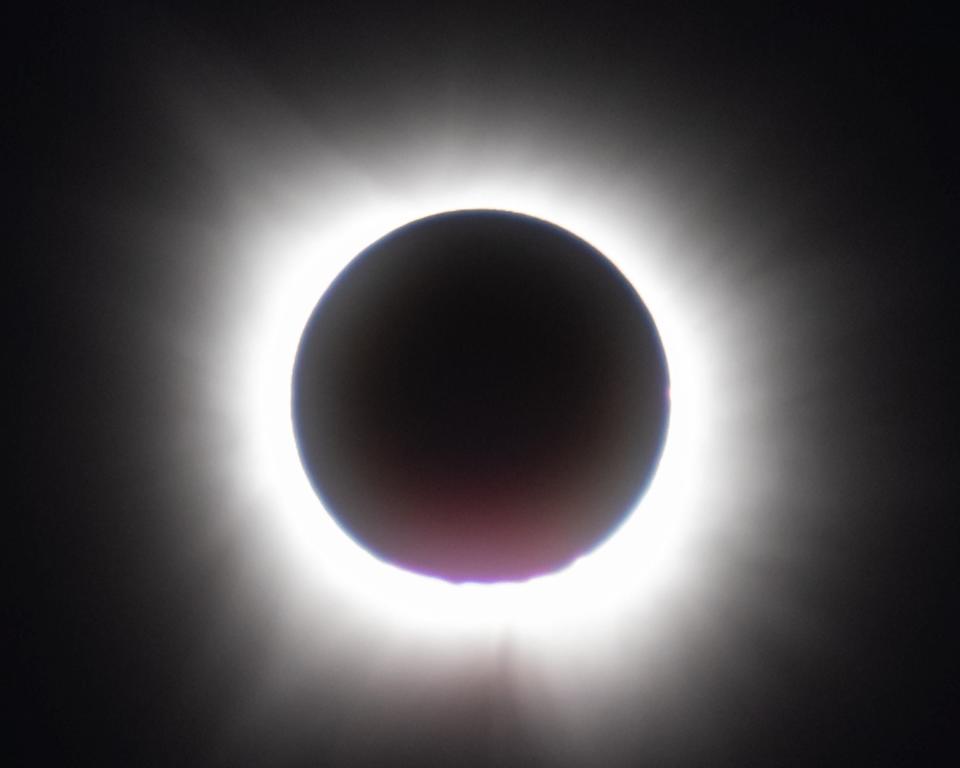Total solar eclipses are becoming more rare. Here's why 'it's all downhill from here.'
Monday's total solar eclipse won't be the last chance for most people to see one in their lifetimes, but as one YouTube educator argues, "it's all downhill from here."
For millions of people across North America, the celestial display was truly a once-in-a-lifetime event to witness. No total solar eclipse of recent memory has been as spectacular, astronomers say, and none in the next two decades will come close to recapturing its majesty.
And while it won't happen in our lifetime, there will come a point in the next billion years when total solar eclipses don't occur at all. That's according to Henry Reich, the creator of the popular YouTube video series MinutePhysics, which has more than 5.76 million subscribers.
Months before the eclipse even happened, Reich shared a video in December on the channel explaining why such cosmic events are becoming more and more rare.
"We are in the golden age of eclipses but only for the moment," said Reich, an expert in physics who created the educational channel in 2011. "In fact, I'd argue we're already past peak solar eclipse, and it's all downhill from here."

See what an eclipse looks like on Mars: NASA shares photos from Red Planet ahead of April 8 totality
Why annular eclipses now occur more frequently than total eclipses
Though it didn't used to be this way, annular and partial solar eclipses now occur more frequently than total solar eclipses.
And why those events can be plenty captivating, let's face it: Nothing compares to the awe-inspiring phenomenon of totality.
That moment isn't just defined by the uncharacteristic daytime darkness that unfolds when the moon appears large enough in its orbit to block the sun's disc. During totality, the sun's outer atmosphere known as the corona, which is normally lost in the sun's bright glare, makes a dazzling appearance.
But as the centuries have gone by, total eclipses have only become more and more rare, Reich said in the MinutePhysics video, which was supported by the NASA Heliophysics Education Activation Team.
Using the channel's signature whiteboard animation, Reich explained how changes to Earth's and the moon's imperfect orbits have affected their relative distances and sizes to the sun, thereby altering the types of solar eclipses visible from our planet.
Watch the MinutePhysics video here:
The moon was likely much closer to Earth than it is now when it formed billions of years ago, making total eclipses much more common as the moon was big enough to blot out the sun, Reich said. As time went on – and we're talking billions of years, here – tidal forces transferred some of the earth's rotational momentum to the moon, sending the moon farther and farther away, Reich explained.
As a result, partial or annular eclipses only became more common. Today, they now occur much more frequently that total eclipses, Reich explained.
And sometime in the next billion years, Reich claims that the moon will only get farther away until eventually, Earth will experience the last total solar eclipse.
At that time, Reich said, "the golden age of eclipses on Earth will be over."
Where are can you see upcoming total solar eclipses worldwide?
Americans with updated passports who are willing to travel don't have to wait for another 20 years until a total solar eclipse is visible in the United States.
The next total solar eclipse to occur anywhere in the world will be August 12, 2026 when one passes over Spain, Iceland, and Greenland, according to NASA. Then, another one will occur about a year later on August 2, 2027 over North Africa.
Those in the U.S. planning to stay put will be waiting until Aug. 23, 2044 for a total solar eclipse. And with only three states on the path – Montana, North Dakota and South Dakota – the next North American eclipse won't have nearly as big of a reach as the Monday celestial event that blanketed 13 states.
Outside of the lower 48 states, Alaska is set to experience a total solar eclipse on March 30, 2033, according to nationaleclipse.com.
Eric Lagatta covers breaking and trending news for USA TODAY. Reach him at elagatta@gannett.com
This article originally appeared on USA TODAY: Total solar eclipses are becoming more rare. YouTuber explains why.

